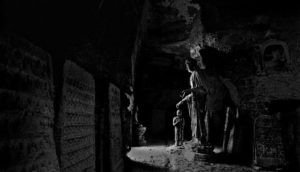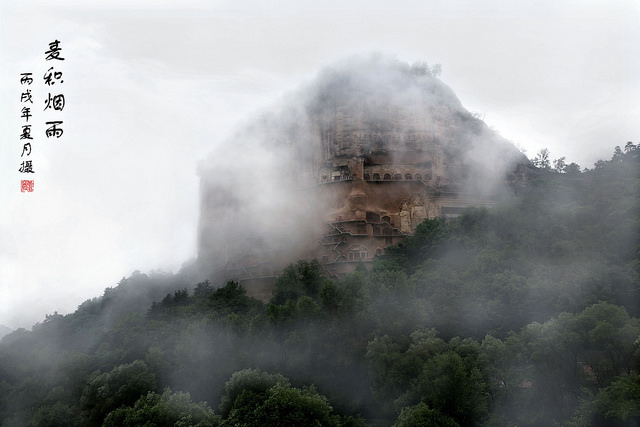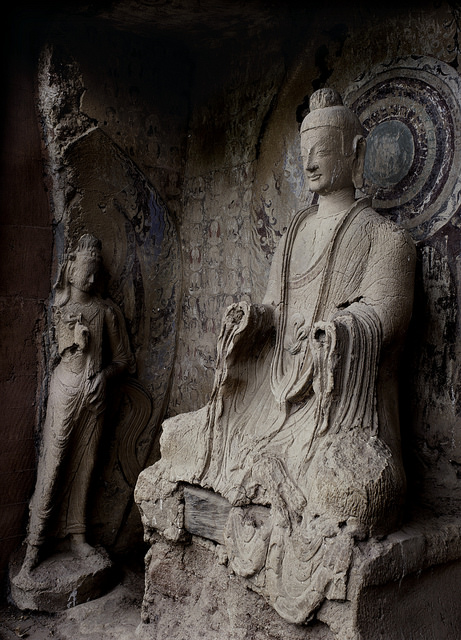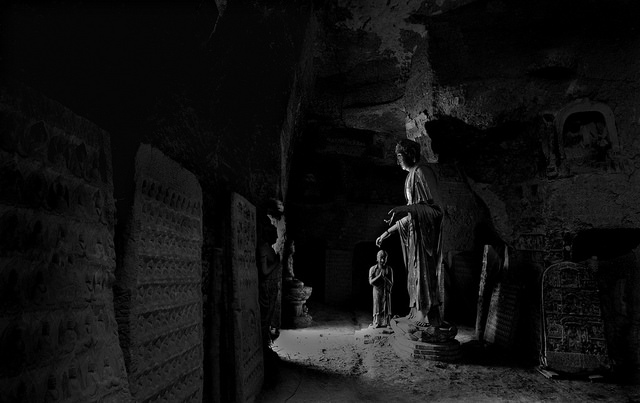
Unmatched by the immovable stone of a massive cliff-like form, the wind bows to the unwavering integrity of the mountain, but cuts through the zigzagging maze of rickety, ancient wooden stairs, built centuries before on the mountain’s face, with the tautness of snapping fingers. Each crackle courses through pine boards in a ceaseless chorus of sound. There are places where they creak, places where they sing in low sonorous tones. There are places where the worms had eaten holes through the wood, creating small portholes through which one can see the forests of the valley floor far below………
“This is one of the most overlooked sites in China,” said Kuanghan Li. “Not many people have heard of it. Yet, it is also one of the most important. These places were built by imperial families for hundreds of years.”
It is not an understatement to say that Kuanghan Li, Global Heritage Fund’s Director of the China Heritage Program, is optimistic about the prospects for Maijishan, one of a handful of Buddhist caverns found in the country. From the train station, however, there’s little to see of one of China’s, and the world’s, most significant Buddhist complexes.
Ms. Li, Nada Hosking, Global Heritage Fund’s Director of Programs and Partnerships, and I had just arrived in Tianshui, a small, industrial city in China’s remote Gansui province. As we wound our way through its rain-choked streets, I tried to imagine the site as I had seen it from pictures. A tall, tawny-colored mountain, Maijishan appeared to me as a prominent bluff overlooking a primeval forest of oaks and pine. In the winter, the snow seasoned the worked stone with an austere grandeur, though its starkness seemed to herald the beauty of the spring yet to come.
Maijishan was more majestic in person than could be imagined. From our vantage point a giant emerged, appearing to rise at least 1,000 feet from the ground. The clay buddhas that adorned its side were massive structures some 100 feet tall and clearly visible from the visitor center half a mile away. The combination of forest, mountain, and sky, all wreathed in a midsummer mist, provided a sublime visual context.
____________________________________
Maijishan in a sea of fog. ©Maijishan Grotto Art Institute and Global Heritage Fund
_________________________________________
After waiting for a short time in the offices of the Maijishan Art Research Institute, our partner in conserving Maijishan’s Buddhist heritage, we are assigned an English-speaking guide to take us up to the mountain. The wooden staircases that were once used by the monks have long since been removed, and in their place, an extensive series of concrete stairs and niches have been constructed to allow access to visitors.
Climbing these stairs, one encounters the first prominent feature — three large buddhas installed centuries ago into the mountain’s outer wall, those that appeared so small from afar on first reckoning. Their sheer size cannot be conveyed through words or pictures; craning my neck upward, I could only view them in their entirety before the strain became uncomfortable. After several flights of stairs, I was able to appreciate each segment in turn, their painted feet, their long-flowing robes, their serene faces radiating serenity, their benevolent eyes.
Like all of Maijishan’s sculptures, these are not made from stone but from a wooden skeleton overlaid with clay and then painted. Each successive generation of monks would maintain and embroider the mountain’s many art installations, adding their own unique veneer to more than 2,000 years of history. In their absence, the sculptures, frescoes, and other artworks have decayed. With these massive sculptures, where the facade has rotted away, it is possible to discern their superstructures.
To me at least, it’s clear why this site has enchanted so many over the millennia.
“It is as if one were to mount a carriage and pierce the mountain, carving out great niches” the sixth-century poet Yü Hsin wrote on an inscription upon a wall in one of Maijishan’s many grottoes. Though his original work is lost, his words remain to convey the awe, the power, and the majesty of this celestial confabulation: in his poems, Maijishan’s sacred caves were “carved in the darkness of the mountain peak” before earthquakes buried them, its walls “covered with inscriptions taken from holy scripture”1 until the paint faded away, the surrounding land bathed in brilliance by “an infinite medley of stars overhead” before the advent of industry polluted the skies.
The Sheaves of Wheat Mountain
You don’t need poetry to understand why Maijishan cuts an impressive figure, and there are many candidates to explain its magnificence. Extolled as the “Sheaves of Wheat Mountain” since the early fifth century, Maijishan’s golden-hued stone contrasts markedly with the greens and browns of the forest, the blue of the local rock, and the clear, pure waters of the springs. It appears like a crown amid dull trinkets. “Up and down is 80,000 feet” one record reads, a bit of ridiculousness that does not diminish the dizzying sheerness of the mountain’s heights and the fear they inspire in everyone but the birds, the grottoes’ only inhabitants now that the original stepladders and stairs have all rotted away.
Located only a few miles south of the main road between China and Central Asia, Maijishan became a center of cross-cultural pollination for hundreds of thousands of itinerants and a historical record written in the art of 12 separate dynasties. Indians, Mongols, Huns, Sogdians, Tibetans, Chinese, and others passed through its halls as they passed through the pages of history, each leaving an indelible piece of themselves behind.
The mountain’s 194 grottoes are a testament to their influence. They come in seven architectural variations, are home to over 7,000 statues, and are covered in more than 100 square meters of murals. Everything is dedicated to the pursuit of Buddhism, from the artworks depicting the birth of Siddhartha to bodhisattvas contorting themselves in meditation to the arrival of new devotees. While its physical attributes may have led to its initial prominence, it was this heritage, written and painted and sculpted upon the soft golden stone, that cemented it in the consciousness of globalized Buddhism as a cousin to Mount Sumeru, the Buddhist holy mountain, “the mythical axis of the universe.”2
The history of Maijishan, like the history of all things along these ancient trade routes, begins with a journey. In one account, the priest Hsüan-kao came to Maijishan and meditated there before forming his own ascetic system. He was later joined by the shaman T’an-Hung, who arrived at Maijishan sometime between 420 and 422. They “became good friends” and inaugurated the holy mountain’s first monastic community. After it grew to nearly 300 people, the two masters departed, Hsüan-kao for another master and T’an-Hung for Cochin, where his suicide through self-immolation is recorded in morbidly poetic terms: those who bore witness “saw Hung with a golden body, riding very swiftly westward on a golden deer.”3 — the picture of insanity tinged by religious fervor.
This semi-mythical beginning may or may not be true, but it is indisputable that Maijishan soon became an important religious site to the rulers of China. In the Sung Dynasty-era book Fang-yü sheng-lan, a historian explains, “Yao Hsing carved the mountains and made 1,000 cliffs and 10,000 images, turning the cliff into halls.” Thereupon [it became] Chin Chou’s place of scenic beauty.”4 A stele from 1222 declares that 10,000 people prayed at the site, empires gave the priests grants of land for farming, and seven kingdoms “continuously”5 repaired it. Later empires found it important to issue imperial decrees on its name, declaring it first “Ching-nien ssu” then “Ying-chien kan ssu” and then “Jui-ying ssu” before settling, finally, on Maijishan.
But, as a consequence of its strategic location alongside the Silk Road, not even royal patronage could ensure the safety and tranquility of the Buddhist community at Maijishan. Successive kingdoms fought over the ownership of the site from its foundation, with five different governments contesting control between 385 and 446 AD. It is not hard to imagine that Maijishan was far less tranquil than the average monastic community.
The earliest cave art dates from sometime in the fifth century, but scholars are divided as to whether they were made before or after the anti-Buddhist persecutions of 446-452.6 Visiting in the eighth century, the poet Tu Fu adapted the work of his predecessor Yü Hsin to write poignantly about the cruelty of time:
There are few monks left in these remote shrines,
And in the wilderness the narrow paths are high.
The musk-deer sleep among the stones and bamboo,
The cockatoos peck at the golden peaches.
Streams trickle down among the paths;
Across the overhanging cliff the cells are ranged,
Their tiered chambers reaching to the very peak;
And for 100 li one can make out the smallest thing.7
And yet, a stele from the Ming Dynasty in 1642 declares that “from Yao-Chin until now has been 1,300-some years and the incense fires have never stopped,”8 a powerful testament to its longevity through the turbulent years of war. It was not until the 18th century that the grottoes saw their end as a functioning monastic community.
________________________________________
A buddha and bodhisattva preside in one of the grottoes at Maijishan. ©Maijishan Grotto Art Institute and Global Heritage Fund
_________________________________
A detail from a fresco in Maijishan. ©Maijishan Grotto Art Institute and Global Heritage Fund
____________________________________________________
Preserving Maijishan
As one of the four main large grottoes in China, the Maijishan Grottoes were announced as part of the priority group of heritage sites to be placed under emphasis by the State Department in 1961. On 22 June 2014, at the 38th World Heritage Site Nomination Conference held in Doha, Qatar, the Maijishan Cave-Temple Complex was inscribed onto the World Heritage List as part of the series of sites under “Silk Roads: The Routes Network of Chang’an-Tianshan Corridor.” Significant improvements have been made on the surrounding environment of the heritage sites following inscription. Nevertheless, appropriate preservation and management is crucial at Maijishan to ensure that the values of authenticity and integrity are retained.
“It has not undergone a lot of major intervention, at least in modern times,” Kuanghan Li says of the site. “It’s still pretty much intact and authentic. Now, with the whole [UNESCO] nomination and the development of the Chinese domestic tourism market, it’s getting more and more popular. There’s a lot of risk involved.”
For now, the main problem plaguing the site is tourism. During 2016’s May Day holiday, over 30,000 people visited the site in a single day, breaking all of its past records. Furthermore, Maijishan lacks much of the documentation and planning of other Chinese grottoes; not only does it not have a proper conservation history, it also does not have an archival record, making it difficult to understand the scope and extent of the threats to the site’s physical, built heritage.
According to Ms. Li, the following are priorities for conserving Maijishan’s spectacular tradition of Buddhist cave art:
- There is an urgent need for visitor management plans to be put in place to prepare for the increase in tourists,9 so as to prevent any destruction that may threaten the integrity of the site.
- Lack of appropriate expertise in restoring and maintaining the site may also result in the deterioration of valuable heritage material.
- In addition, some of the caves suffer from natural erosion.10 Proper frameworks and expertise are required to ensure that sculptures and paintings are preserved.
- While preserving the site, innovative solutions are needed to enhance access in a way that does not compromise visitor experience, or impose on surrounding communities.
To develop solutions to these issues, Global Heritage Fund is partnering with the Maijishan Grottoes Art Research Institute, which has served as a source of research and expertise on the Maijishan Cave Temple Complex. Since the establishment of the Gansu Province Cultural Department, the Maijishan Grottoes Art Research Institute has further refined its methodology and has been providing integrative services related to preservation, research, and tourist reception at Maijishan.
According to the current conditions and needs at the Maijishan Grottoes site and in line with the skills of our partners, the three main goals for Global Heritage Fund’s work are:
- Develop an operational strategy for visitor management and establish relevant courses for members of staff and volunteers at the site, including access, interpretation, visitor capacity and technology-led education.
- Conduct a systematic examination of Maijishan’s historic preservation, including restorative principles, techniques, and methods, and use it as a foundation for building up further scientific analysis and comprehensive proposals. This will help to create comprehensive frameworks for restoring and maintaining the site’s colored sculptures and mural paintings.
- Create a community development program focused on the living communities within the park. Activities will include education, handicraft development and promotion, and sustainable community-based tourism development and training.
As to the future of conservation at Maijishan, Ms. Li has this to say: “We hope to develop a good management plan so there is something they can run and sustain in the long term. The Maijishan Grottoes Art Research Institute has had trouble attracting staff, because the site is so remote. This isn’t as bad as it sounds, however. They mostly hire from the villages around the area, who use more traditional techniques and methods of restoration. This is a good thing overall since it helps the community and maintains the integrity of the site. We’re hoping to add to this by giving more study to these traditional methods, and helping them build off this foundation to work toward a more systematic conservation method and plan – instead of just introducing modern conservation methods very abruptly and then overrun what they’ve done before.”
______________________________________
After the religious community of Maijishan departed, most of Maijishan fell into neglect. In the absence of artificial lighting, this grotto has fallen into darkness. ©Maijishan Grotto Art Institute and Global Heritage Fund
______________________________________
Readers can learn more about the Global Heritage Fund and its unique mission to preserve the world’s heritage here.
__________________________________________________
Notes:
1. Sullivan 6
2. Sullivan 1
3. Mai-chi shan 482
4. Ibid., 482
5. Ibid., 483
6. Ibid., 484
7. Sullivan 7
8. Ibid., 483
9. http://whc.unesco.org/en/list/1442
10. http://www.shanghaidaily.com/national/Buddhist-effigies-put-into-digital-catalogue/shdaily.shtml
Sources:
http://whc.unesco.org/en/tentativelists/1631/
Receive 30 days free access to the popular new CuriosityStream lineup of documentaries on science, history, nature, and technology as a new Popular Archaeology premium subscriber.
___________________________________________
Travel and learn with Far Horizons.
______








